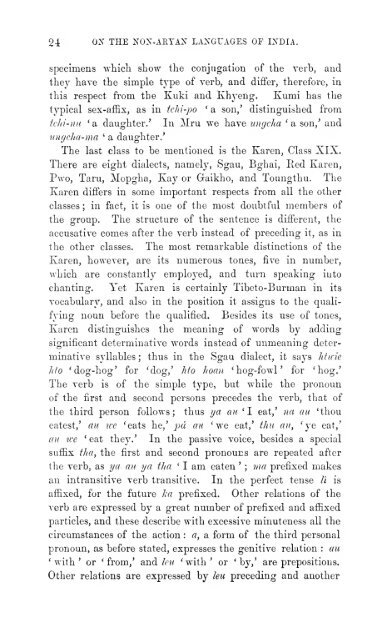You also want an ePaper? Increase the reach of your titles
YUMPU automatically turns print PDFs into web optimized ePapers that Google loves.
24<br />
ON THE NOX-ARTAN LANGUAGES OF INDIA.<br />
specimens whicli show <strong>the</strong> conjugation <strong>of</strong> <strong>the</strong> verb, and<br />
<strong>the</strong>y have <strong>the</strong> simple type <strong>of</strong> verb, and differ, <strong>the</strong>refore, in<br />
this respect from <strong>the</strong> Kuki and Khyeng. Kumi has <strong>the</strong><br />
tjqDical sex-affix, as in tchi-po ' a son,* distinguished from<br />
tchi-mi * a daughter.' In Mru we have ungcha ' a son,' and<br />
ungcha-ma ' a daughter.'<br />
The last class to be mentioned is <strong>the</strong> Karen, Class XIX.<br />
There are eight dialects, namely, Sgau, Bghai, Red Karen,<br />
Pwo, Taru, Mopgha, Kay or Gaikho, and Toungthu. The<br />
Karen differs in some important respects from all <strong>the</strong> o<strong>the</strong>r<br />
classes ; in fact, it is one <strong>of</strong> <strong>the</strong> most doubtful members <strong>of</strong><br />
<strong>the</strong> group. The structure <strong>of</strong> <strong>the</strong> sentence is different, <strong>the</strong><br />
accusative comes after <strong>the</strong> verb instead <strong>of</strong> preceding it, as in<br />
<strong>the</strong> o<strong>the</strong>r classes. The most remarkable distinctions <strong>of</strong> <strong>the</strong><br />
Karen, however, are its numerous tones, five in number,<br />
which are constantly employed, and turn speaking into<br />
chanting. Yet Karen is certainly Tibeto-Burman in its<br />
vocabulary, and also in <strong>the</strong> position it assigns to <strong>the</strong> quali-<br />
fying noun before <strong>the</strong> qualified. Besides its use <strong>of</strong> tones,<br />
Karen distinguishes <strong>the</strong> meaning <strong>of</strong> words by adding<br />
significant determinative words instead <strong>of</strong> unmeaning deter-<br />
minative syllables; thus in <strong>the</strong> Sgau dialect, it says hticie<br />
hto * dog-hog' for 'dog,' hto hoan 'hog-fowl' for 'hog.'<br />
The verb is <strong>of</strong> <strong>the</strong> simple type, but while <strong>the</strong> pronoun<br />
<strong>of</strong> <strong>the</strong> first and second persons precedes <strong>the</strong> verb, that <strong>of</strong><br />
<strong>the</strong> third person follows; thus ya au 'I eat,' na au 'thou<br />
eatest,' au we 'eats he,' pd au 'we eat,' thu an, 'ye eat,'<br />
au we ' eat <strong>the</strong>y.' In <strong>the</strong> passive voice, besides a special<br />
suffix i/ui, <strong>the</strong> first and second pronouns are repeated after<br />
<strong>the</strong> verb, as ya au ya tha ' I am eaten '<br />
; ma prefixed makes<br />
an intransitive verb transitive. In <strong>the</strong> perfect tense li is<br />
affixed, for <strong>the</strong> future ka prefixed. O<strong>the</strong>r relations <strong>of</strong> <strong>the</strong><br />
verb are expressed by a great number <strong>of</strong> prefixed and affixed<br />
particles, and <strong>the</strong>se describe with excessive minuteness all <strong>the</strong><br />
circumstances <strong>of</strong> <strong>the</strong> action : a, a form <strong>of</strong> <strong>the</strong> third personal<br />
pronoun, as before stated, expresses <strong>the</strong> genitive relation : au<br />
' with ' or ' from,' and leu ' with ' or ' by,' are prepositions.<br />
O<strong>the</strong>r relations are expressed by leu preceding and ano<strong>the</strong>r

















